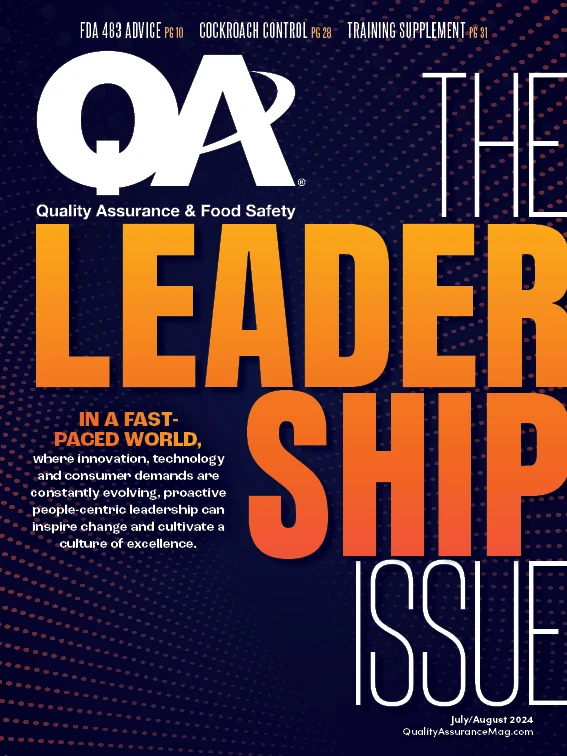
The number 483 holds little meaning for much of the world, but for the food industry, a “483” is something to be avoided, not only for itself but for its potential to lead to a publicly published Warning Letter.
The FDA 483, named for the form on which it is written, may be issued to a firm at the end of an FDA inspection if the inspector observed conditions believed to constitute breaches in the regulatory requirements. Its purpose is to describe indications that a food has been adulterated or could become adulterated or injurious to public health.
When a 483 is received, it is a serious issue that requires a response within 15 business days of receipt. It is critical that firm management carefully review the observations, determine the root cause, take corrective action to mitigate the issue and ensure against repeat occurrence, and respond to FDA stating these. If FDA does not receive a response, or if it deems the response is inadequate, it can take various actions, including issuing a warning letter or advising the firm of its continuing concerns and the need for prompt action to adequately correct the violations. At this point, failure to respond or adequately address the issues could lead to enforcement action.
RESPONSE LETTERS. To appropriately respond to a 483 or a warning letter:
- Act quickly. FDA expects a quick response that shows an effort is being made to determine the root cause of the issues and that a corrective action plan is being put in place with a realistic time frame.
- To ensure you clearly communicate these, we recommend you first write a draft; have it reviewed internally or with a consultant to ensure it is clear, compelling and thorough; make any needed revisions; and then send to FDA.
- We also advise the inclusion of a cover letter from senior management acknowledging the concerns that were cited and trying to anticipate any additional details FDA might request.
- Cite supportive facts and data, including documentation, and make sure all is clear and easy to follow. A thorough response often requires a lot of information, and you are best served to connect all the dots for FDA rather than making them wade through a lot of disconnected information.
- If your initial response to a 483 or warning letter indicated a planned (rather than taken) action, you should provide FDA with a clear timeline and then regular updates on the progress.
- Be prepared for a possible reinspection, as FDA may want to check progress or ensure you have done what you said you would.
LEARNING LESSONS. While a firm should learn from any 483s or warning letters it receives, more proactive is learning lessons from others. Warning letters are publicly posted on the FDA website, so you can review these to assess your own compliance. Regular reading of warning letters can help you understand the level of scrutiny that FDA takes and the kind of concerns they have to help you avoid similar issues — and similar letters!
If you do realize you have a similar issue, reviewing FDA’s description of what was done incorrectly or is needed for correction by another firm can help you appropriately address your issue before it can become cited in your facility as an FDA observation.
A few examples of recent warning letter citations include:
- Lack of a food safety plan, including the lack of a hazard analysis identifying where preventive controls were needed.
- GMP violations due to use of a household cleaner not for use on food contact surfaces for cleaning the facility and equipment.
- Pest violations, including observations of rodent excreta pellets in the warehouse and on product and packaging. Also observed were gaps around doors, open doors and overgrown vegetation near the building perimeter.
- Salmonella and Listeria monocytogenes contamination in a pet food plant that was identified as a recurring issue, as previous FDA sampling had indicated pathogen contamination of product.
FDA is looking closely for a wide range of regulatory violations across all industry segments it regulates. When serious issues aren’t corrected, they can result in significant food safety issues that can lead to recalls, consumer illness or injury, and intensive regulatory scrutiny. So promptly detecting and addressing issues in your facility can help you avoid public health issues — and prevent your becoming a recipient of an unwelcome notice from FDA.

Explore the July/August 2024 Issue
Check out more from this issue and find your next story to read.
Latest from Quality Assurance & Food Safety
- IDFA Presents Leadership Award to Six Federal Officials at Annual Celebration of Dairy Reception
- Seeding The Future Global Food System Challenge is Changing Lives: Winners Reflections
- Raw Farm Products Recalled Following Bird Flu Virus Detections
- FDA Issues 2024 Voluntary National Retail Food Regulatory Program Standards
- GSA Launches Assurances Platform, Prism and Webinar Series in Partnership with Wholechain
- Multistate E. coli Outbreak Linked to Iceberg and Romaine Lettuce Blend
- FDA, USDA Seek Information About Food Date Labeling
- William Marler, Food Safety Advocate and Lawyer, Condemns Lack of Safety of U.S. Food Supply





